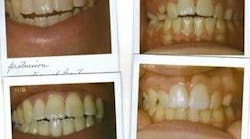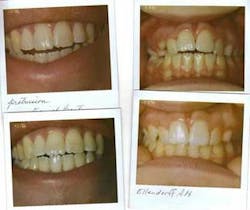Recognizing tongue thrust patients can be very useful. They have a difficult orthodontic road ahead, and if their tongue thrust goes untreated, relapse of the orthodontic correction is almost guaranteed. Thumb sucking causes teeth to protrude due to the force the thumb exerts on the maxillary incisors. A swallow in which the tongue is placed on or through the teeth also causes an anterior open bite. (Fact: Did you know the tongue is widely considered the strongest muscle in the body?) A juvenile tongue thrust swallow converts to a “normal” swallow in most people around the age of 7 or 8. For those unable to make the transition, which may be due to blocked nasal passages or a digit-sucking habit, the tongue thrust can hamper normal facial and skeletal development.
Muscle function often dictates the form of the face and teeth. A mouth breather may have an elongated face due to the jaw dropping open. This occurs because the tongue does not rest in the palate with the mouth open. The force of the cheek muscles “draws in” the arch and creates a vaulted palate. Unilateral crossbite can also develop when a finger sucker places the fingers to one side of the cheek. The muscles - buccinator and zygomatic major - are drawn in and exert pressure on the teeth, causing a crossbite on one side. If the habit is stopped, the teeth will move back to normal alignment if that is the only problem the child has. Thumb sucking also affects the “s” and “z” sounds in speech due to how the tongue is placed. Speech disorders benefit from tongue thrust therapy in conjunction with speech therapy. A child will be set up for failure if the speech problem but not the tongue thrust problem is treated.
For a person to develop a normal swallow pattern, he or she must be able to breathe through the nose. With the mouth closed, the tongue should rest in the palate and the teeth should come together to swallow saliva. The tongue also helps give the palate its shape. The lips keep the teeth from protruding by staying closed. In those who cannot keep their lips together, a slight curl to the upper lip is noticeable and the muscles surrounding the mouth are engaged to close the lips, which isn’t comfortable.
For normal development to occur, we must address habits that can have negative effects. Therefore, thumb suckers and pacifier users should be talked to at an early age, and terminating the habit before permanent teeth erupt is advantageous. Also, the proper physicians should address nose-breathing issues. A mouth breather generally becomes a tongue thrust swallower, which creates a hostile environment for an orthodontist.
How can a dental hygienist help? Ask questions when you see an anterior open bite. Is there a sucking habit? Can you breathe through your nose? What do Mom and Dad look like? Oftentimes parents appreciate help talking to their child. If it’s a breathing issue, they need to know the possible long-term effects and be given an ENT referral. Nose breathing is healthier and allows for normal facial development as well as occlusion. Detecting a tongue thrust swallower requires a hands-on approach. In a normal swallow, the tongue rests in the palate, the teeth come together, and a person swallows. The facial muscles (obicularis oris) do not move, so any lip puckering or licking of the lips before swallowing should be warning signs of tongue thrust. In a tongue thrust swallower, the tongue pushes forward and the lips make the seal. This results in the chin contracting and the other muscles around the mouth moving. So if a hygienist asks the patient to swallow while holding his or her bottom lip out so as to see the swallow, the person has a very hard time swallowing. He/she may even pull the lower lip out of the hygienist’s grasp in the process!
The treatment that corrects tongue thrust swallow and digit sucking is orofacial myology. Never heard of it? Orofacial myology (the study of muscles around the face and mouth) began with an orthodontist looking for a better way to treat his tongue thrust patients. He approached speech pathologists because they seemed the natural ones to address the tongue and its muscles. The practice of orofacial myology is now open to dental hygienists too. (Check out www.IAOM.com for details about courses.)
I have met many patients who had orthodontics, only to have it relapse due to their tongue thrust. Normal development follows when the lips close at rest, the tongue rests in the palate, and the force of the swallow is against the palate. When the mouth hangs open or the lips don’t close comfortably, and the force of the swallow is forward, the facial structure and oral structures become altered. Orthodontic correction without addressing these issues is a recipe for relapse.
Although a “crib” or habit reminder from the orthodontist can affect the tongue and teeth, it doesn’t address the lips and tongue resting posture. One approach is a quick fix, the other a permanent solution. You can help patients make an informed choice. Early intervention can save years of orthodontics and help in the success of orthodontics as well. Without the tongue pushing on the teeth, open bites begin to close, making future needs for the orthodontic patient minimal. Maturity of the patient helps success, but certainly knowledge of the problem is a large part of the battle.
Connie L. Sidder, RDH, is based in Fort Collins, Colorado. Her orafacial/myology business, Smiles Preventive Dental Services, is also based in Fort Collins. She can be contacted at considder@gmail.







